Solar Panels on agricultural land vs Commercial Rooftop Solar
The Solar Surge and the Countryside Conundrum
The UK is on the cusp of a solar revolution. With a government pledge to more than triple solar generation capacity from 16.6 gigawatts (GW) to 45–47 GW by 2030, the pressure is on to identify viable locations for solar installations. While large-scale solar panels on agricultural land are gaining traction, the growing debate centres on whether this push compromises rural landscapes and food security. An emerging alternative is hiding in plain sight: commercial rooftop solar.
The Farmland Debate: Climate Needs vs. Agricultural Preservation
The urgency to expand solar power is real. Ten large-scale solar farm proposals in the East of England and Northamptonshire alone span 24,000 acres and could collectively produce 4.3 GW of electricity surpassing even the planned 3.2 GW output of the Sizewell C nuclear power station. Advocates see these solar panels on agricultural land installations as essential for addressing the climate emergency. However, critics warn of unintended consequences.

Using prime farmland for solar energy infrastructure raises serious concerns:
Food Security:
Large solar panel farms may hinder essential practices like crop and field rotation, deteriorating soil health over time.
Visual and Ecological Impact:
Rural settings face disruption, both aesthetically and ecologically.
Economic Pressure on Farmers:
As climate variability and extreme weather events challenge traditional farming, landowners increasingly consider solar projects for supplemental income, sometimes at the expense of productive land.
The Overlooked Opportunity: Rooftop Solar on Commercial Buildings
With rising resistance to land-use changes in the countryside, a clear alternative emerges which makes use of the underused sources of energy contained within commercial and industrial rooftops. As the energy sector faces mounting pressure to meet net-zero targets, commercial property rooftops offer a sustainable and largely untapped avenue for solar deployment.
Why commercial Rooftop solar?
Efficiency:
Generating electricity where it is consumed reduces transmission losses. This decentralised generation model also reduces the need for extensive grid infrastructure expansion.
Affordability:
Commercial rooftop solar installations can significantly lower electricity bills, making them particularly attractive for businesses coping with high energy costs. Over time, solar investments can improve energy independence and protect against price volatility.
Scalability:
The Campaign for Rural England (CPRE) research estimates 250,000 hectares of south-facing industrial roof space across the UK more area than the cities of London and Manchester combined. This indicates vast potential for expansion without disrupting natural or agricultural landscapes.
Untapped Commercial Rooftop solar SOURCES
Solar Generation:
Utilising just 5% of this roof space (approximately 2,500 hectares) could generate around 25 GW of electricity, nearly half the solar output target advised by the Climate Change Committee (CCC). This demonstrates the significant impact even limited rooftop utilisation could make.
Warehousing Sector:
The UK Warehousing Association highlights that the top 20% of warehouses alone could contribute 75 million square meters of solar-ready roof space. These facilities often have flat, unshaded roofs ideal for large-scale photovoltaic (PV) systems and are typically located near energy demand centres.
Moreover, rooftop installations avoid many of the planning and environmental concerns tied to ground-mounted systems. They can be implemented more quickly, with fewer objections from local communities, and they raise the sustainability credentials of the businesses that adopt them. In sectors increasingly held accountable for ESG (Environmental, Social, and Governance) performance, commercial rooftop solar presents a dual benefit of operational savings and reputational gain

Current State and Challenges
Despite this vast potential, commercial rooftop installations represent only 50,000 of the UK’s 870,000 solar PV systems, contributing just 1.2 GW of the 4.1 GW installed under the Feed-In Tariff (FIT) scheme. This is in marked contrast to many other European countries. For example, in Germany, more than half of solar PV deployment is on commercial roofs.
So why is it like this in the UK? We explain more below:
Legal Complexity:
The fragmented ownership and tenancy structures typical of commercial real estate present significant hurdles. In buildings where tenants lease space, coordination between landlords, occupants, and third-party investors is required. This makes contractual arrangements, particularly under the Power Purchase Agreement (PPA) model, complex and time-consuming to negotiate. Issues such as access rights, maintenance responsibilities, and energy distribution need to be carefully managed to protect all parties involved.
Financing Hurdles:
Post-subsidy economics have left many prospective investors uncertain about the long-term return on investment. The absence of government-backed financial support schemes means commercial solar projects must now compete with other investment opportunities, making it harder to justify initial outlay costs. Furthermore, smaller businesses often lack the capital or risk appetite to pursue solar independently, while larger institutions face internal competition for investment resources.
A Dual-Model solution Approach
Self-Financed Systems:
In this model, building owners or occupants fund and own the solar installation outright. It offers the greatest long-term savings and energy autonomy but requires significant upfront investment. It’s often most viable for large companies with stable cash flows and a commitment to sustainability.
Power Purchase Agreements (PPAs):
Under a PPA, a third-party investor finances the system, installs and maintains it, while the building occupier purchases the electricity at a fixed rate. While this reduces the need for capital investment from the business, it introduces complexity in contractual agreements and often involves lengthy due diligence processes. Nevertheless, it remains a key option for enabling faster, broader adoption.
Policy Recommendations and the Way Forward
To truly release the power of rooftop solar, targeted government support is vital:
Incentives:
Introduce or reinstate financial incentives such as tax credits, grants, or low-interest loans to lower the barriers to entry for businesses considering rooftop solar.
Regulation Simplification:
Establish standard agreements and clear legal frameworks to simplify negotiations between landlords, tenants, and solar providers.
Public Sector Leadership:
Require new and existing public buildings such as schools, hospitals, and administrative facilities to incorporate solar technologies, setting an example for the private sector and stimulating demand for rooftop installations.
Choosing the Right Commercial Solar Path
Balancing renewable energy goals with food security and countryside conservation is a complex challenge.
While farmland solar installations offer rapid gains, they carry environmental and socio-economic trade-offs. Rooftop solar, especially on commercial and industrial buildings, presents a strategic and sustainable solution, one that exploits existing infrastructure to meet climate goals without sacrificing agricultural productivity.
As the UK aims to reach 70 GW of solar capacity by 2035, prioritising commercial rooftops could prove to be both a smart and responsible path forward.
Book your free site survey today and start your journey to energy independence.
